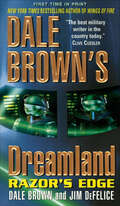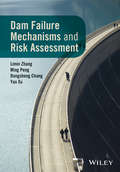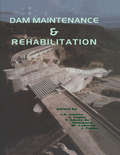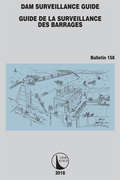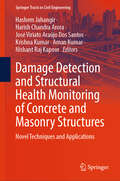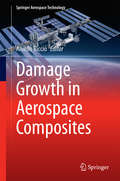- Table View
- List View
Dalbergia sissoo: Biology, Ecology and Sustainable Agroforestry
by Siddra IjazDalbergia sissoo (Shisham) is a perennial tree species native to the Asian subcontinent. It is an economically significant tree for its value in forestry, agroforestry, and horticulture. The high-quality timber imparts this tree species a significant commercial value. Besides valuable timber, it also exhibits medicinal, industrial, and agroforestry allied attributes. This tree has been introducing to the geographical regions where it does not exist naturally, which indicates its significant properties, getting diverse communities' attention. This book provides information about this tree species based on the latest research trends and development on the subject. It addresses researchers, forestry specialists, natural resource managers, or all those interested in the rehabilitation, maintenance, and management of Dalbergia sissoo tree resources. Key features Discusses botanical features, reproductive characters, taxonomy, geographical distribution, and ecological importance of Dalbergia sissoo. Highlights physiological and biochemical features of Dalbergia sissoo and vis-à-vis contribution to the sustainability of the ecosystem. Explains ethnobotany of Dalbergia sissoo, its ethnobotanical uses to cure various ailments, and contribution to the pharmaceutical industry. Provides a comprehensive account of insect pest threat and diseases as a leading cause of deteriorating growth, cultivation, productivity, and quality losses in Dalbergia sissoo. Describes conventional breeding methods and non-conventional strategies for genetic improvement, biodiversity, and conservation of D. sissoo Relays sustainability, socio-economic importance, agroforestry trends, current scenario, and future challenges of D. sisso
Dale Brown's Dreamland: End Game (Dreamland Thrillers #8)
by Dale Brown Jim DeFeliceAn experimental weapon must be deployed to save a US ally from terrorists in the New York Times–bestselling author’s military techno-thriller.India is the latest target of radical Islamic jihadists. The world watches as tensions escalate between the uneasy giant and its longtime nemesis Pakistan—with China waiting in the wings, eager to flex its military might. The only hope of avoiding a nuclear showdown is found inside a top-secret military facility deep in the Nevada desert . . . Dreamland is where the future of high-tech warfare is conceived and constructed. Now its masterminds are charged with the task of locating the mysterious source of the terror and ending it—swiftly and permanently.Every technological wonder in their arsenal is utilized—from an awesome new hybrid Navy destroyer to robot Flighthawks. But the fate of the region and the world will depend on the newest brainchild of the Dreamland team: an unproven instrument of ultimate power code-named End Game.
Dale Brown's Dreamland: Razor's Edge (Dreamland Thrillers #3)
by Dale Brown Jim DeFeliceThe hunt is on for a mystery weapon shooting down American planes over Iraq in the New York Times–bestselling author’s high-tech military thriller series.Hidden in the Nevada desert is Dreamland—a top-secret research center developing experimental artillery and aircraft that push beyond the cutting edge. It is also home to Whiplash—a covert team of special forces trained to deploy the high-tech weapons in extreme situations. Whiplash’s latest mission begins when a series of American planes are shot down over Iraq in mysterious circumstances. There is no way that conventional weapons could have executed the deadly efficient strikes. Can the Iraqis have developed a laser capable of causing such mayhem? Fearing a major international crisis, the President sends a call out to Dreamland. Within hours, some of the most sophisticated aircraft in the world are heading for the Gulf, with orders to track down the mystery weapon—and destroy it.
Dale Brown's Dreamland: Retribution (Dreamland Thrillers #9)
by Dale Brown Jim DeFeliceThe elite Dreamland team faces their most deangerous mission as terrorists plot a massive nuclear attack on American soil in this military techno-thriller.Dreamland, a top-secret military facility in the Nevada desert, is where high-tech innovations are developed to keep America safe from its enemies. After defusing threats across the globe, the team must now use its stealth, raw nerve, and technology to stop a terror from striking at home. With more than two dozen nuclear devices unaccounted for, the global masters of terror have set a catastrophe in motion: a surprise attack more deadly than Pearl Harbor and 9/11 combined. If the nation is to survive, Lieutenant Colonel Tecumseh “Dog” Bastian and his crew will have to reach deep into their cutting-edge arsenal. And they’ll have to do it short-handed—because two of Dreamland’s best and bravest have been lost at sea.
Dale Brown's Dreamland: Satan's Tail (Dreamland Thrillers)
by Dale Brown Jim DeFeliceNew York Times–Bestselling Authors: When terrorists take to the sea, America attacks from the air . . . In the Nevada desert, the high-tech future of warfare is being built at a top-secret military facility called Dreamland . . . As extremist Islamic pirates, armed and supported by a powerful Saudi terrorist, prey on civilian vessels in the Gulf of Aden, America aggressively answers with serious muscle—a next-generation littoral warship with a full range of automated weapons systems that the enemy has dubbed “Satan's Tail.” But unforeseen technological problems—combined with the suicidal tendencies of a fanatical foe—mean support is needed from above, and a pair of Dreamland’s awesome Megafortresses and their Flighthawk escorts are dispatched to the war zone. However, bitter professional rivalries threaten to damage, perhaps even destroy, the mission, as a vengeful opponent takes advantage of the disruption to strengthen his outlaw navy and set its sights horrifically high—raising the stakes in a battle the U.S. and the world simply cannot afford to lose.Acclaim for Dale Brown“When a former pilot turns his hand to writing thrillers you can take their authenticity for granted. His writing is exceptional and the dialogue, plots and characters are first-class.” —Sunday Mirror“Few novelists can craft an aerial battle scene more strategically.” —Publishers Weekly“Brown puts us into the cockpits of wonderful machines and gives us quite a ride . . . authentic and gripping.” —The New York Times
Dale Brown's Dreamland: Strike Zone (Dreamland Thrillers #5)
by Dale Brown Jim DeFeliceIn this military thriller, the Dreamland team must track down a new super-weapon shockingly similar to its own bleeding edge technology.An Asian war that would have escalated into a nuclear nightmare has been halted, thanks to the raw courage, unparalleled skill, and total commitment of the Dreamland force. But an analysis of radar data has revealed the presence of an unknown super-weapon in the area: a robot warplane with terrifying capabilities, dubbed the “ghost clone.” Though seemingly related to Dreamland’s own U/MF Flighthawk, no one knows where this fearsome instrument of destruction originated. And a rogue nation possessing a squadron of them could wreak unimaginable havoc on an unsuspecting free world. Now nothing less than a brazen, brilliantly conceived deception will lure the ghost clone out of hiding—and only a daring strike on enemy soil can avert a tomorrow too terrible to consider . . . if it isn’t already too late.
Dale Earnhardt Jr.: Out of the Shadow of Greatness
by Mike HembreeDale Earnhardt Jr.’s name virtually assured that his life would not be ordinary. Over the past decade, he has fulfilled that destiny. His father, one of the most successful drivers in the history of international motorsports, gave his son more than his name. Dale Earnhardt Sr. placed Dale Jr. in position to follow the footsteps and tire tracks he had left from Darlington to Daytona, from coast to coast, from one championship to the next. Entering 2001, Junior was set to turn the sport on its ear. Instead, his world was rocked in the first race of the season when Dale Sr., racing behind him in a wild finish to the Daytona 500, crashed into the outside wall and was killed. The racing world mourned, and Junior’s life changed in many ways. Dale Earnhardt Jr.: Out of the Shadow of Greatness tells the story of this remarkable young man’s journey from teenage dreamer to Winston Cup winner, from Street Stock racer to 200 mph superstar, from son of the greatest to a champion in his own right. Against the backdrop of one of sport’s biggest tragedies, he continues to carry the Earnhardt name to new heights. This newly revised edition is a must for any NASCAR fan.
Dam Failure Mechanisms and Risk Assessment
by Limin Zhang Ming Peng Dongsheng Chang Yao XuThis book integrates the physical processes of dam breaching and the mathematical aspects of risk assessment in a concise manner • The first book that introduces the causes, processes and consequences of dam failures• Integrates the physical processes of dam breaching and the mathematical aspects of risk assessment in a concise manner• Emphasizes integrating theory and practice to better demonstrate the application of risk assessment and decision methodologies to real cases• Intends to formulate dam-breaching emergency management steps in a scientific structure
Dam Maintenance and Rehabilitation II
by Rafael Romeo García Mario Andreu Mir Francisco HijósBitrián Raimundo Lafuente Dios MoisésRubín de Célix Caballero Mariano de Andrés Rodríguez-Trelles Alejandro Carrasco Mínguez María Soledad Martín-Cleto Sánchez Miguel Alonso Pérez de Ágreda José María Villarroel González-ElipeAs dams age, they are subject to a series of external agents and processes which tend to deteriorate the qualities with which they were originally conceived to stand against these actions. At the same time, it is often necessary to respond to increased safety standards, either in the structural or hydrological fields. Reservoir sedimentation or wat
Dam Maintenance and Rehabilitation: Proceedings of the International Congress on Conservation and Rehabilitation of Dams, Madrid, 11-13 November 2002
by J. A. Llanos J. Yagüe F. Sáenz de Ormijana M. Cabrera J. PenasDuring the life of a dam, changes in safety standards, legislation and land use will inevitably occur, and functional deterioration may also appear. To meet these challenges, these Proceedings from a panel of international experts assess, define and re-evaluate the design criteria for the construction of dams and the many attendant issues in on-going maintenance and management. Authors include international specialists: academics, professionals and those in local government, utilities and suppliers. Practitioners from these same fields will find the book a useful tool in acquiring a comprehensive knowledge of managing and retrofitting dams, so that they can continue to meet society's needs.
Dam Protections against Overtopping and Accidental Leakage
by Eugenio Oñate Miguel Ángel Toledo Rafael MoránIn the last decades, the technology of dam protection has undergone major advancements. The increasing demand for safety in modern society has created the need for cost-effective measures to protect critical infrastructure such as dams. This situation has resulted in the drafting of new regulations and technical manuals in countries like Norway, Sw
Dam Safety Management / Gestion de la Sécurité des Barrages: Pre operational phases of the dam life cycle / Phases de conception, construction et mise en service (ICOLD Bulletins Series #175)
by Cigb IcoldDam Safety Management is a major concern during the entire lifetime cycle of a dam scheme. This is particularly true for the operational phase of the scheme that represents by far the longest period in its lifetime cycle. Bulletin 154 presented a general approach and concepts to be applied to dam operation. The current Bulletin 175 extends the developed concepts to all phases preceding the operational phase. Many risks associated with the operation of existing dams have their origins in other phases preceding the actual operation. Although there are numerous ICOLD Bulletins addressing technical aspects of planning, design, construction and commissioning of dams, there is not a single Bulletin which covers the subject in a comprehensive manner. The current document is a first attempt to capture all relevant dam safety aspects in all preoperational phases by systematically characterizing the actors involved, their roles, the activities and complex interactions present in different phases of the dam lifecycle. An Overarching Safety Management System is specifically developed that can be applied to all actors involved. La gestion de la sécurité des barrages est une préoccupation majeure pendant tout le cycle de vie d'un projet de barrage. Cela est particulièrement vrai pour la phase opérationnelle du système qui représente de loin la période la plus longue de son cycle de vie. Le Bulletin 154 présente une approche générale et des concepts à appliquer à l'exploitation des barrages. Le Bulletin 175 actuel étend les concepts développés à toutes les phases précédant la phase d'exploitation. De nombreux risques associés à l'exploitation des barrages existants ont leur origine dans d'autres phases précédant l'exploitation proprement dite. Bien qu'il existe de nombreux bulletins ICOLD traitant des aspects techniques de la planification, de la conception, de la construction et de la mise en service des barrages, il n'existe pas un seul bulletin qui couvre le sujet de manière exhaustive. Le document actuel est une première tentative de capturer tous les aspects pertinents de la sécurité des barrages dans toutes les phases pré-opérationnelles en caractérisant systématiquement les acteurs impliqués, leurs rôles, les activités et les interactions complexes présentes dans les différentes phases du cycle de vie du barrage. Un système global de gestion de la sécurité est spécifiquement développé et peut être appliqué à tous les acteurs impliqués.
Dam Surveillance Guide (ICOLD Bulletins Series #158)
by Nathalie SchaunerDams are part of human achievements that induce great benefits for society but also bear a potential risk to people, property and the natural environment. The risk of a dam rupture is extremely low and diffi cult to quantify accurately. The aim of ‘Dam surveillance’ (ICOLD Bulletin 158), is to help reduce these risks by early detection of an undesirable event. The objective of dam surveillance is to make a precise and timely diagnosis of the behavior of dams, in order to prevent undesirable consequences. Both the monitoring system and surveillance program has to be designed and should be able to detect any abnormal behaviour. ‘Dam surveillance’ (ICOLD Bulletin 158), emphasizes the following aspects: • Routine visual inspection • Special inspection • Checking and testing of Hydro-electromechanical equipment • Monitoring parameters and devices • Automation • Maintenance of ageing monitoring systems • Re-instrumentation of existing dams • Recent developments • Data management • Dam documentation management • Assessment of dam condition and behaviour • Assessment of routine dam safety monitoring programme • Prioritization of maintenance, remedial and upgrading works.
Dam Surveillance – Lessons Learnt From Case Histories / Surveillance des Barrages – Leçons Tirées d’Études de cas: Bulletin 180 (ICOLD Bulletins Series #180)
by International Commission on Large Dams Commission Internationale Des Grands BarragesICOLD Bulletin 180 presents the vast experience gained over the past 6 decades by the dam engineering community in the field of dam surveillance by means of 80 case histories. The documented case histories endeavour to cover the practical experiences related with one or several of the following points: a) Methods for the improvement of the quality and reliability of information. b) Data processing and representation techniques. c) Effective Diagnostic analyses to determine behaviour patterns. d) Dedicated surveillance systems for the optimization of maintenance, rehabilitation, and other life cycle costs. e) Impact of surveillance on preventing dam incidents and dam failure. f) Overview of dam surveillance management systems. The case histories cover a wide variety of technical aspects and deal with success stories but also incidents, some of them with catastrophic consequences. The time framework spans over 70 years: from the times of the Second World War up to the present. The purpose is to learn from these practical experiences, not to criticize the involved individuals, who had to work with the techniques and rules of practice available at the time. This bulletin wants to contribute to keep learning from the experience of the dam engineering community, specifically in the field of dam surveillance. Some of the case histories are widely known and have been described and analysed in numerous publications. Most of them are related to famous dam failure incidents and were compiled as international “benchmark case histories” for this bulletin to focus on the specific lessons learnt related with dam surveillance. Le Bulletin de la CIGB 180 présente la vaste expérience acquise au cours des 6 dernières décennies par la communauté des ingénieurs de barrages dans le domaine de la surveillance des barrages au moyen de 80 histoires de cas. Les histoires de cas documentées s'efforcent de couvrir les expériences pratiques liées à un ou plusieurs des points suivants : a) Méthodes d'amélioration de la qualité et de la fiabilité de l'information. b) Techniques de traitement et de représentation des données. c) Analyses diagnostiques efficaces pour déterminer les modèles de comportement. d) Systèmes de surveillance dédiés pour l'optimisation de la maintenance, de la réhabilitation et des autres coûts du cycle de vie. e) Impact de la surveillance sur la prévention des incidents et des ruptures de barrage. f) Aperçu des systèmes de gestion de la surveillance des barrages. Les histoires de cas couvrent une grande variété d'aspects techniques et traitent de réussites mais aussi d'incidents, dont certains avec des conséquences catastrophiques. Le cadre temporel s'étend sur 70 ans : de l'époque de la Seconde Guerre mondiale à nos jours. Le but est d'apprendre de ces expériences pratiques, pas de critiquer les individus impliqués, qui ont dû travailler avec les techniques et les règles de pratique disponibles à l'époque. Ce bulletin veut contribuer à continuer d'apprendre de l'expérience de la communauté de l'ingénierie des barrages, en particulier dans le domaine de la surveillance des barrages. Certaines des histoires de cas sont largement connues et ont été décrites et analysées dans de nombreuses publications. La plupart d'entre eux sont liés à des incidents de rupture de barrages célèbres et ont été compilés en tant qu'« histoires de cas de référence » internationales pour ce bulletin afin de se concentrer sur les leçons spécifiques apprises liées à la surveillance des barrages.
Dam and Levee Safety and Community Resilience
by Committee on Integrating Dam Levee Safety Community ResilienceAlthough advances in engineering can reduce the risk of dam and levee failure, some failures will still occur. Such events cause impacts on social and physical infrastructure that extend far beyond the flood zone. Broadening dam and levee safety programs to consider community- and regional-level priorities in decision making can help reduce the risk of, and increase community resilience to, potential dam and levee failures. Collaboration between dam and levee safety professionals at all levels, persons and property owners at direct risk, members of the wider economy, and the social and environmental networks in a community would allow all stakeholders to understand risks, shared needs, and opportunities, and make more informed decisions related to dam and levee infrastructure and community resilience. Dam and Levee Safety and Community Resilience: A Vision for Future Practice explains that fundamental shifts in safety culture will be necessary to integrate the concepts of resilience into dam and levee safety programs.
Damage Control (A Jonathan Grave Thriller #4)
by John GilstrapA hostage crisis in Mexico turns into a deadly game of cat and mouse in this international thriller by the New York Times bestselling author. They were on a mission trip to Mexico to help with earthquake recovery. But in Ciudad Juarez, the busload of well-meaning adults and teenagers became hostages. The ransom demands of their captors are explicit: deliver three million dollars--with zero involvement from law enforcement--or all captives will be executed. But rescue specialist Jonathan Grave doesn't believe in ultimatums. For Grave and his elite team at Security Solutions, it's all about protecting the innocent. When the delicate situation explodes in violence, he must flee with the survivors. Now Grave must face the chilling possibility that someone within the U.S. government has a deadly secret to protect--one that could jeopardize national security like never before. . .&“The action is nonstop. Gilstrap knows his technology and weaponry. Damage Control will blow you away.&”—Suspense Magazine
Damage Detection and Structural Health Monitoring of Concrete and Masonry Structures: Novel Techniques and Applications (Springer Tracts in Civil Engineering)
by Krishna Kumar Aman Kumar Hashem Jahangir Harish Chandra Arora José Viriato Araújo Dos Santos Nishant Raj KapoorThis book offers the use of artificial intelligence, image processing, model analysis, laser scanners, shearography, drones, contourlet, wavelet, signal processing techniques and other SHM techniques to detect the damages in the concrete as well as masonry structures. Corrosion is one major factor that causes reinforced concrete structures to deteriorate over time. However, the degrading process is not evenly distributed throughout the structure. The damage can be detected timely and the structure's degradation model can be updated with the help of proper monitoring and inspection techniques. The damages in the masonry structures may happen due to moisture ingress, cracking, mortar failure, settlement and spalling, etc. Structure health monitoring (SHM) may assist in understanding the structures deterioration mechanisms and reducing the ongoing deterioration in a scientific manner. A complete detail of both the traditional and cutting-edge approaches used in the SHM process is described in this book. The latest non-destructive techniques and semi-destructive techniques shall also be discussed in this book. This book aids academics and industry professionals with recent developments in SHM techniques. Additionally, it encourages researchers in coming up with creation of newer applications in structural engineering.
Damage Growth in Aerospace Composites (Springer Aerospace Technology)
by Aniello RiccioThis book presents novel methods for the simulation of damage evolution in aerospace composites that will assist in predicting damage onset and growth and thus foster less conservative designs which realize the promised economic benefits of composite materials. The presented integrated numerical/experimental methodologies are capable of taking into account the presence of damage and its evolution in composite structures from the early phases of the design (conceptual design) through to the detailed finite element method analysis and verification phase. The book is based on the GARTEUR Research Project AG-32, which ran from 2007 to 2012, and documents the main results of that project. In addition, the state of the art in European projects on damage evolution in composites is reviewed. While the high specific strength and stiffness of composite materials make them suitable for aerospace structures, their sensitivity to damage means that designing with composites is a challenging task. The new approaches described here will prove invaluable in meeting that challenge.
Damage Mechanics
by George Z. Voyiadjis Peter I. KattanBefore a structure or component can be completed, before any analytical model can be constructed, and even before the design can be formulated, you must have a fundamental understanding of damage behavior in order to produce a safe and effective design. Damage Mechanics presents the underlying principles of continuum damage mechanics along with the
Damage Mechanics in Metal Forming: Advanced Modeling and Numerical Simulation (Wiley-iste Ser.)
by Khemais SaanouniThe aim of this book is to summarize the current most effective methods for modeling, simulating, and optimizing metal forming processes, and to present the main features of new, innovative methods currently being developed which will no doubt be the industrial tools of tomorrow. It discusses damage (or defect) prediction in virtual metal forming, using advanced multiphysical and multiscale fully coupled constitutive equations. Theoretical formulation, numerical aspects as well as application to various sheet and bulk metal forming are presented in detail.Virtual metal forming is nowadays inescapable when looking to optimize numerically various metal forming processes in order to design advanced mechanical components. To do this, highly predictive constitutive equations accounting for the full coupling between various physical phenomena at various scales under large deformation including the ductile damage occurrence are required. In addition, fully 3D adaptive numerical methods related to time and space discretization are required in order to solve accurately the associated initial and boundary value problems. This book focuses on these two main and complementary aspects with application to a wide range of metal forming and machining processes. Contents 1. Elements of Continuum Mechanics and Thermodynamics.2. Thermomechanically-Consistent Modeling of the Metals Behavior with Ductile Damage.3. Numerical Methods for Solving Metal Forming Problems.4. Application to Virtual Metal Forming.
Damage Mechanics of Cementitious Materials and Structures (Wiley-iste Ser. #606)
by Gilles Pijaudier-Cabot Frédéric DufourThe book, prepared in honor of the retirement of Professor J. Mazars, provides a wide overview of continuum damage modeling applied to cementitious materials. It starts from micro-nanoscale analyses, then follows on to continuum approaches and computational issues. The final part of the book presents industry-based case studies. The contents emphasize multiscale and coupled approaches toward the serviceability and the safety of concrete structures.
Damage Tolerance in Advanced Composites
by Robert L. SierakowskiThis recent book provides a detailed presentation of damage tolerance assessment and characterization methods for advanced composites, as well as an examination of the role of damage tolerance in the design of composites. Included are analytical models for different types of damage in different composite materials. Tables provide helpful reference
Damage Tolerance of Metallic Aircraft Structures
by Sérgio M. Tavares Paulo M. de CastroThis book provides a state-of-the-art review of the fail-safe and damage tolerance approaches, allowing weight savings and increasing aircraft reliability and structural integrity.The application of the damage tolerance approach requires extensive know-how of the fatigue and fracture properties, corrosion strength, potential failure modes and non-destructive inspection techniques, particularly minimum detectable defect and inspection intervals. In parallel, engineering practice involving damage tolerance requires numerical techniques for stress analysis of cracked structures. These evolved from basic mode I evaluations using rough finite element approaches, to current 3D modeling based on energetic approaches as the VCCT, or simulation of joining processes. This book provides a concise introduction to this subject.
Damage and Cracking of Concrete Structures: From Theory to Practice
by Jacky Mazars Stephane GrangeDamage and Cracking of Concrete Structures: From Theory to Practice
Damage and Failure of Composite Materials
by Chandra Veer Singh Ramesh TalrejaUnderstanding damage and failure of composite materials is critical for reliable and cost-effective engineering design. Bringing together materials mechanics and modeling, this book provides a complete guide to damage, fatigue and failure of composite materials. Early chapters focus on the underlying principles governing composite damage, reviewing basic equations and mechanics theory, before describing mechanisms of damage such as cracking, breakage and buckling. In subsequent chapters, the physical mechanisms underlying the formation and progression of damage under mechanical loads are described with ample experimental data, and micro- and macro-level damage models are combined. Finally, fatigue of composite materials is discussed using fatigue-life diagrams. While there is a special emphasis on polymer matrix composites, metal and ceramic matrix composites are also described. Outlining methods for more reliable design of composite structures, this is a valuable resource for engineers and materials scientists in industry and academia.


